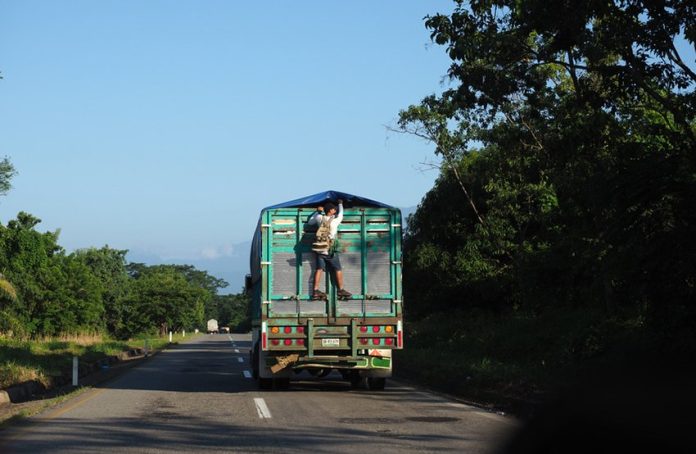A second migrant caravan made up of as many as 2,000 Central Americans entered Mexico yesterday and began the long march towards the United States border.
The migrants, including many women and children, crossed the Suchiate river, which divides Guatemala from the southern state of Chiapas, and defied a heavy Federal Police presence.
As they waded across the murky river, a police helicopter hovered overhead, creating a strong downwash that made crossing difficult and dangerous.
A 25-year-old Honduran man was swept away by the current and was pulled unconscious from the river before being revived by CPR administered by Federal Police and marines.
Once the migrants reached the Mexican side of the border, they were surrounded by police and immigration agents.
National Immigration Institute (INM) commissioner Gerardo Elías García told them they wouldn’t be detained but had to go to immigration offices to formally register their entry into Mexican territory.
To avoid the possibility of another clash similar to the one on Sunday that left one Honduran man dead, Mexican officials allowed the migrants to leave the immigration office at around 2:00pm to start their journey on foot towards the city of Tapachula, about 40 kilometers away.
The interior secretary said in a statement yesterday that two Honduran men were arrested after one of them attempted to shoot at Federal Police in the town of Ignacio Zaragoza, near the border crossing.
However, the gun failed to fire and no agents were injured, the statement said.
With regard to the death of 26-year-old Henry Díaz Reyes, the Honduran government issued a statement yesterday calling for an investigation into what happened amid differing versions of events from the migrants and Mexican authorities.
“As a government, we reject any form of criminalization and violence against migrants and we request that the incident be investigated,” the Honduran foreign department said.
According to the migrants, Díaz was shot in the head by Federal Police with a rubber bullet as they launched an assault on a border barrier that prevented them from entering Mexico.
However, Interior Secretary Alfonso Navarrete Prida said Sunday that police deployed to the border area didn’t have firearms or any weapons that could fire rubber bullets.
The migrants, however, did have weapons, including guns and molotov cocktails, Navarrete charged.
Meanwhile, representatives of the first caravan of migrants, currently in Oaxaca, yesterday demanded “safe and dignified” transport to Mexico City for its 4,000 exhausted members fleeing poverty and violence in their homelands.
Residents of Zanatepec, Oaxaca, organized vehicles to transport the migrants to Santiago Niltepec yesterday but the federal government has not shown any inclination to assist the caravan with their transit through Mexico.
Instead, the government announced an assistance program offering shelter, medical attention, schooling and jobs to the Central American migrants but only if they remained in either Chiapas or Oaxaca.
Migrant advocacy group Pueblos Sin Fronteras (People Without Borders) has said that it hopes to meet with federal lawmakers and authorities in Mexico City as well as members of the incoming government to discuss migrant rights and the future of the caravan.
Today, the first caravan planned to walk to Juchitán, the commercial hub of the Isthmus of Tehuantepec region.
Many migrants remain determined to reach the Mexico-United States border where they intend to apply for asylum despite U.S. President Trump’s threats to stop them at the border.
However, an increasing number of exhausted migrants are becoming disheartened by the long distance still left to travel and appear likely to return home or seek to stay in Mexico.
Hasiel Isamar Hernandez, a 28-year-old mother of three, told the Associated Press that when she heard from her husband that her three-year-old daughter back home had stopped eating because she missed her mother, she knew it was time to turn around.
“Of the friends that I have been with, all want to go back,” she added.
While some migrants have already returned to their country of origin and more look set to do so, others are only in the early stages of their journey.
El Salvador’s immigration agency said that a group of Salvadoran migrants including children and adolescents that entered Guatemala Sunday numbered around 500.
Source: El Universal (sp), Fox News (en), Associated Press (en)
